Fungicide Protection as an Agrotechnical Treatment Reducing Nitrogen Gap in Winter Wheat—A Case Study
Abstract
1. Introduction
2. Materials and Methods
2.1. Experimental Setup
2.2. Experimental Design
- 1.
- Two systems of WW protection with fungicides (CP):
- (1)
- without the use of fungicides—CP-0;
- (2)
- using the fungicides—CP-F.
- 2.
- N control plus six doses of applied N fertilizer: 0, 40, 80, 120, 160, 200, 240 kg ha−1.
2.3. Soil and Plant Sampling
2.4. Calculated Parameters
2.4.1. Nitrogen Gap Indicators
2.4.2. Nitrogen Gain Indicators
2.5. Statistical Analysis
3. Results
3.1. Nitrogen Gap—First
3.2. Nitrogen Pools at Harvest
3.3. Nitrogen Gain
3.4. Nitrogen Gap—Second
4. Discussion
4.1. Nitrogen Pools
4.2. Indicators of Inorganic N Economy in the Soil–Winter-Wheat System
5. Conclusions
Supplementary Materials
Author Contributions
Funding
Data Availability Statement
Conflicts of Interest
Appendix A
| Traits | Nin | PFP-Nin | NG | Ngr | Nhrr | NA | Nminr | Nb | Ng89 | Nint | PFP-Nint | NGt | NR |
|---|---|---|---|---|---|---|---|---|---|---|---|---|---|
| GY | 0.57 *** | 0.08 | −0.10 | 0.90 *** | 0.33 * | 0.82 *** | 0.49 ** | −0.35* | 0.52 *** | 0.81 *** | 0.20 | −0.09 | 0.49 ** |
| Nin | 1.00 | −0.72 *** | −0.88 *** | 0.84 *** | 0.83 *** | 0.90 *** | 0.61 *** | 0.48 ** | −0.24 | 0.89 *** | −0.58 *** | −0.79 *** | −0.35 * |
| PFP-Nin | 1.00 | 0.92 *** | −0.30 | −0.78 *** | −0.44 ** | −0.29 | −0.75 *** | 0.61 *** | −0.44 ** | 0.90 *** | 0.85 *** | 0.79 *** | |
| NG | 1.00 | −0.49 ** | −0.82 *** | −0.60 | −0.45 *** | −0.80 *** | 0.60 *** | −0.61 *** | 0.82 *** | 0.90 *** | 0.67 *** | ||
| Ngr | 1.00 | 0.63 *** | 0.98 *** | 0.62 *** | −0.05 | 0.27 | 0.97 *** | −0.20 | −0.49 ** | 0.15 | |||
| Nhrr | 1.00 | 0.77 *** | 0.58 *** | 0.37 *** | −0.14 | 0.77 *** | −0.79 *** | −0.89 *** | −0.21 | ||||
| NA | 1.00 | 0.65 *** | 0.05 | 0.19 | 0.99 *** | −0.36* | −0.62 *** | 0.08 | |||||
| Nminr | 1.00 | 0.08 | 0.29 | 0.74 *** | −0.42 ** | −0.63 *** | 0.18 | ||||||
| Nb | 1.00 | −0.93 *** | 0.06 | −0.60 *** | −0.55 *** | −0.79 *** | |||||||
| Ng89 | 1.00 | 0.22 | 0.42 ** | 0.30 | 0.80 *** | ||||||||
| Nint | 1.00 | −0.39 * | −0.66 *** | 0.10 | |||||||||
| PFP-Nint | 1.00 | 0.93 *** | 0.55 ** | ||||||||||
| NGt | 1.00 | 0.45 ** |
Appendix B

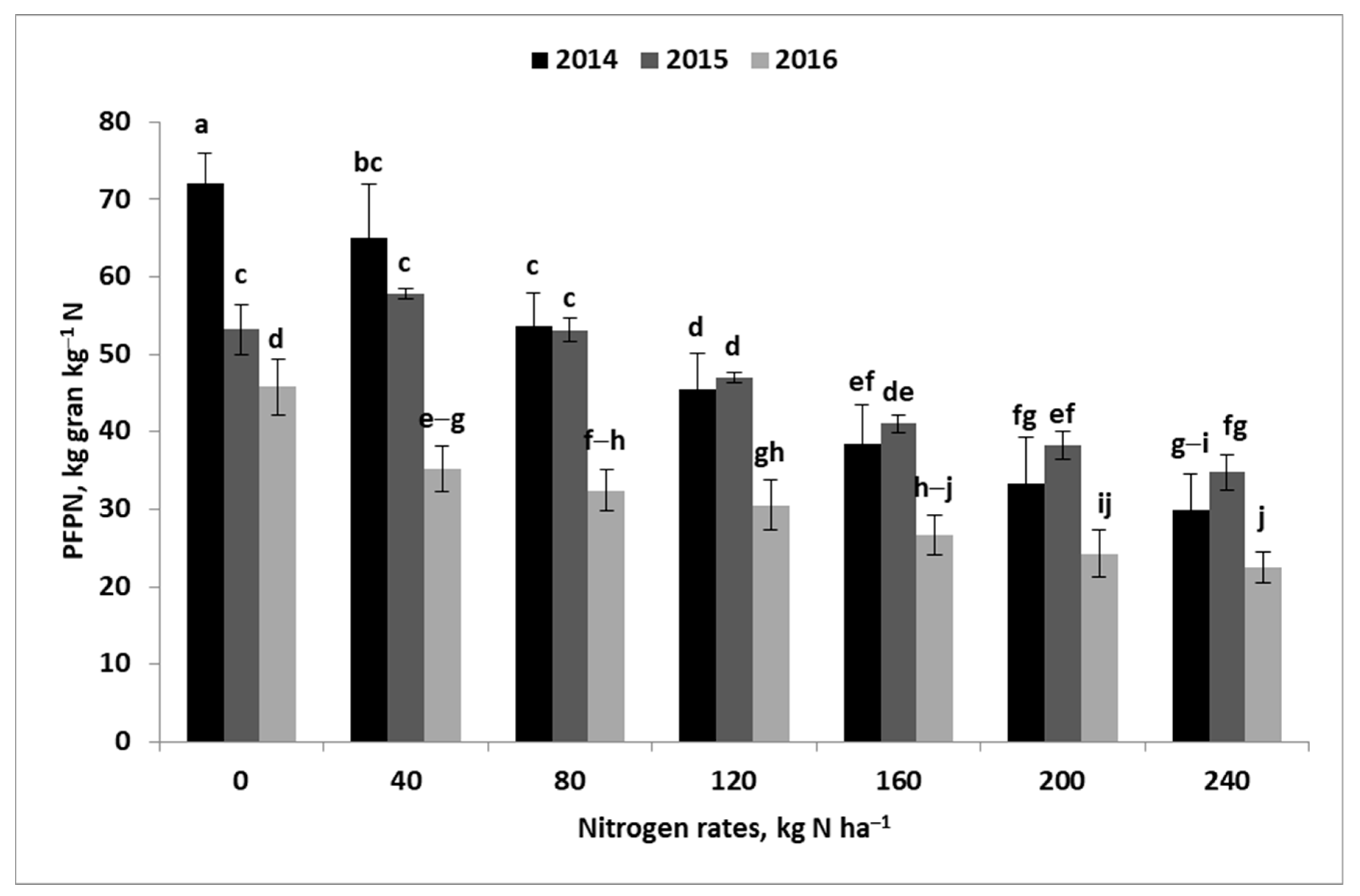
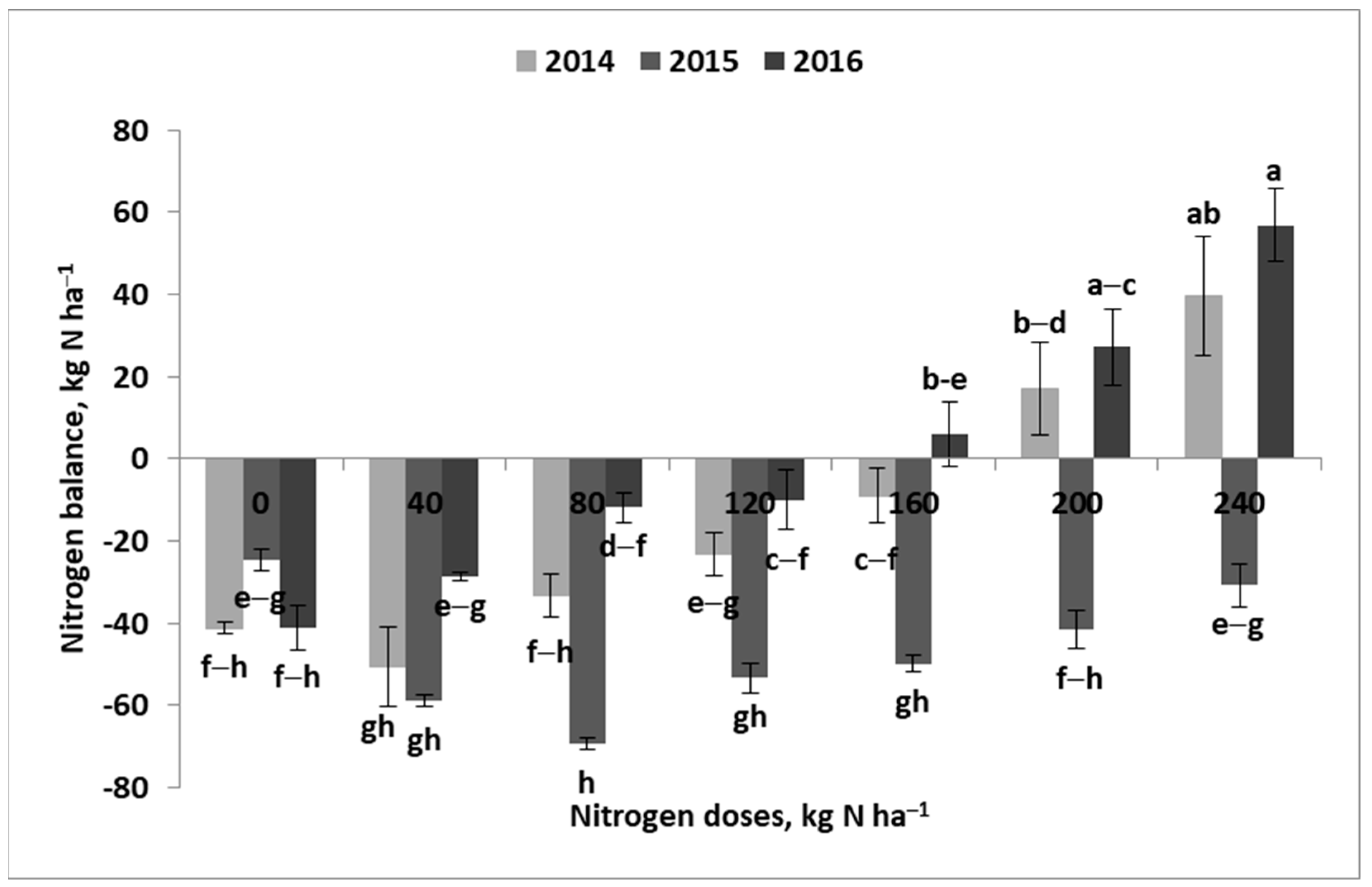
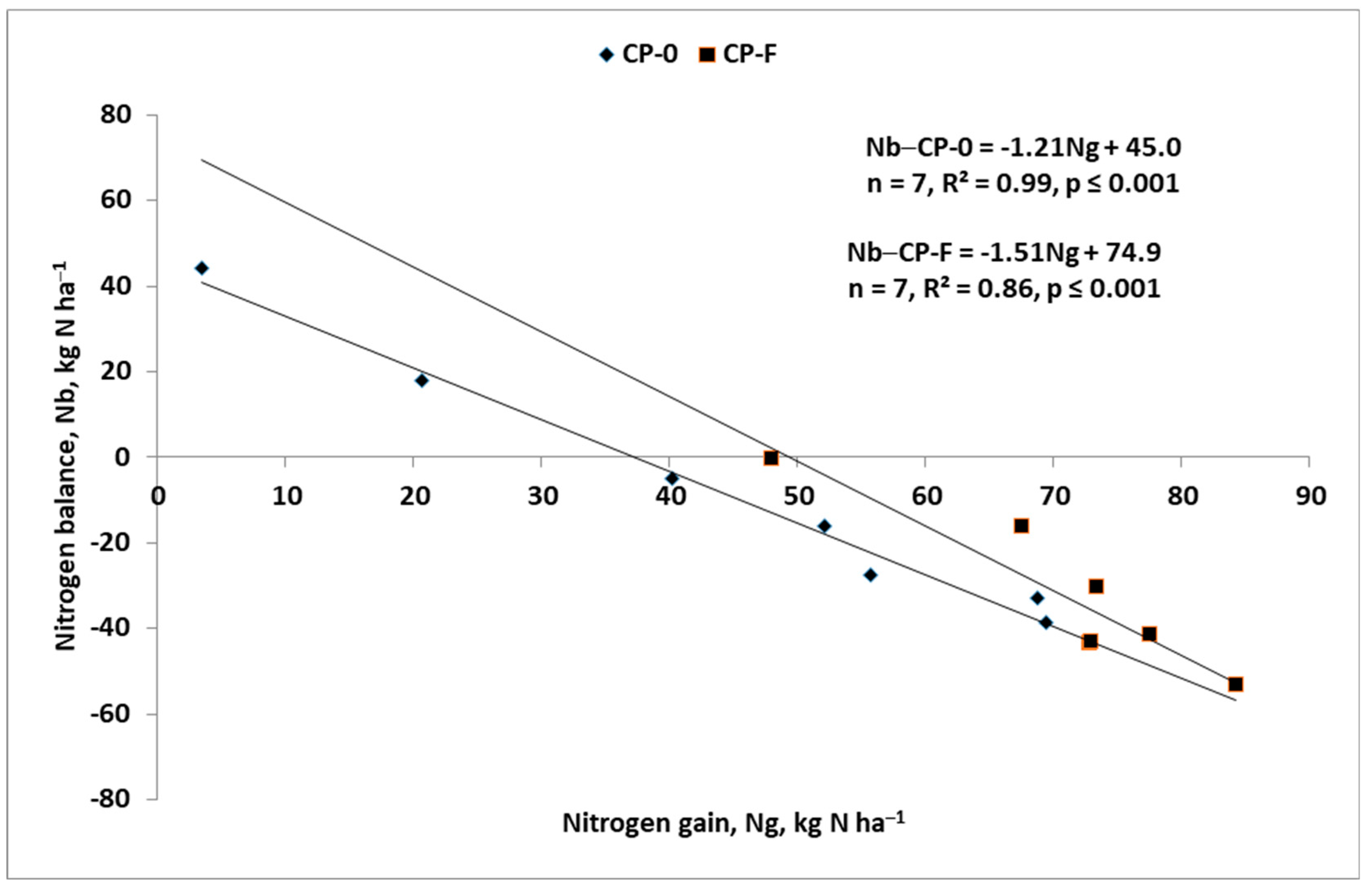


References
- Shewry, P.R.; Hey, S.J. The contribution of wheat to human diet and health. Food Energy Secur. 2015, 493, 178–202. [Google Scholar] [CrossRef] [PubMed]
- Nucia, A. Białka gluteninowe—Charakterystyka i ich wpływ na właściwości reologiczne pszenicy. Agron. Sci. 2018, 73, 5–16. [Google Scholar] [CrossRef]
- Klikocka, H.; Szczepaniak, W. Energy crises—Alternative use of winter bread wheat grain depending on protein content. Agronomy 2023, 13, 861. [Google Scholar] [CrossRef]
- Iwańska, M.; Paderewski, J.; Stępień, M.; Rodrigues, P.C. Adaptation of winter wheat cultivars to different environments: A case study in Poland. Agronomy 2020, 10, 632. [Google Scholar] [CrossRef]
- Hawkesford, M.J.; Riche, A.B. Impacts of G x E x M on nitrogen use efficiency in wheat and future prospects. Front. Plant Sci. 2020, 11, 1157. [Google Scholar] [CrossRef] [PubMed]
- Luce, M.S.; Whalen, J.K.; Ziadi, N.; Zebarth, B.J. Nitrogen dynamics and indices to predict soil nitrogen supply in humid temperate soils. Adv. Agron. 2011, 112, 55–102. [Google Scholar]
- Grzebisz, W.; Łukowiak, R.; Sassenrath, G. Virtual nitrogen as a tool for assessment of nitrogen at the field scale. Field Crops Res. 2018, 218, 182–184. [Google Scholar] [CrossRef]
- Olfs, H.-W.; Blankenau, K.; Brentrup, F.; Jasper, J.; Link, A.; Lammel, J. Soil-and plant-based nitrogen-fertilizer recommendations in arable farming. J. Plant Nutr. Soil Sci. 2005, 168, 414–431. [Google Scholar] [CrossRef]
- Barłóg, P.; Łukowiak, R.; Grzebisz, W. Predicting the content of soil mineral nitrogen based on the content of calcium chloride-extractable nutrients. J. Plant Nutr. Soil Sci. 2017, 180, 624–635. [Google Scholar] [CrossRef]
- Łukowiak, R.; Barłóg, P.; Grzebisz, W. Soil mineral nitrogen and the rating of CaCl2 extractable nutrients. Plant Soil Environ. 2017, 63, 177–183. [Google Scholar] [CrossRef]
- Kong, L.G.; Xie, Y.; Hu, L.; Feng, B.; Li, S.D. Remobilization of vegetative nitrogen to developing grain in wheat (Triticum aestivum L.). Field Crops Res. 2016, 196, 134–144. [Google Scholar] [CrossRef]
- Hodgkinson, L.; Dodd, I.C.; Binley, A.; Ashton, R.W.; White, R.P.; Watts, C.W.; Whalley, W.R. Root growth in field grown winter wheat: Some effects of soil conditions, season and genotype. Eur. J. Agron. 2017, 91, 74–83. [Google Scholar] [CrossRef]
- Giordano, N.; Sadras, V.O.; Lollato, R.P. Late-season nitrogen application increases grain protein concentration and is neutral for yield in wheat. A global meta-analysis. Field Crops Res. 2023, 290, 108740. [Google Scholar] [CrossRef]
- Łukowiak, R.; Grzebisz, W.; Ceglarek, J.; Podolski, A.; Kaźmierowski, C.; Piekarczyk, J. Spatial variability of yield and nitrogen indicators–a crop rotation approach. Agronomy 2020, 10, 1959. [Google Scholar] [CrossRef]
- Taiz, L. Agriculture, plant physiology, and human population growth: Past, present, and future. Theor. Exp. Plant Physiol. 2013, 25, 167–181. [Google Scholar] [CrossRef]
- Simón, M.R.; Fleitas, M.C.; Castro, A.C.; Schierenbeck, M. How foliar fungal diseases affect nitrogen dynamics, milling, and end-use quality of wheat. Front. Plant Sci. 2020, 11, 569041. [Google Scholar] [CrossRef] [PubMed]
- Figueoroa, M.; Hammond-Kosack, K.E.; Solomon, P.S. A review of wheat disease—A field perspective. Mol. Plant Pathol. 2018, 19, 1523–1536. [Google Scholar] [CrossRef]
- Castro, A.C.; Fleitas, M.C.; Schierenbeck, M.; Gerard, G.S.; Simón, M.R. Evaluation of different fungicides and nitrogen rates on grain yield and bread-making quality in wheat affected by Septoria tritici blotch and yellow spot. J. Cereal Sci. 2018, 83, 49–57. [Google Scholar] [CrossRef]
- Matzen, N.; Jørgensen, J.R.; Holst, N.; Jørgensen, L.N. Grain quality in wheat—Impact of disease management. Eur. J. Agron. 2019, 103, 152–164. [Google Scholar] [CrossRef]
- Grzebisz, W.; Diatta, J.; Barłóg, P.; Biber, M.; Potarzycki, J.; Łukowiak, R.; Przygocka-Cyna, K.; Szczepaniak, W. Soil Fertility Clock—Crop rotation as a paradigm in nitrogen fertilizer productivity control. Plants 2022, 11, 2841. [Google Scholar] [CrossRef]
- Mehlich, A. Mehlich 3 soil test extractant: A modification of Mehlich 2 extractant. Com. Soil Sci. Plant Anal. 1984, 15, 1409–1416. [Google Scholar] [CrossRef]
- Kęsik, K. Application of the Mehlich 3 method in the fertilizer advisory system. Stud. I Rap. IUNG-PIB 2016, 48, 95–104. (In Polish) [Google Scholar]
- Zbíral, J. Determination of plant-available micronutrients by the Mehlich 3 soil extractant—A proposal of critical values. Plant Soil Environ. 2016, 62, 527–531. [Google Scholar] [CrossRef]
- PN-EN ISO 20483:2014-02; Cereal Grains and Pulses—Determination of Nitrogen Content and Conversion to Crude Protein—Kjeldahl Method. PKN: Warsaw, Poland, 2015; p. 24.
- Szczepaniak, W.; Grzebisz, W.; Potarzycki, J. Yield Predictive Worth of Pre-Flowering and Post-Flowering Indicators of Nitrogen Economy in High Yielding Winter Wheat. Agronomy 2023, 13, 122. [Google Scholar] [CrossRef]
- Ellmann, T. Effect of intensity of agricultural techniques and grain storage on technological quality of winter wheat, Part I. Quality traits of grain and flour. Acta Sci. Polonorum. Agric. 2011, 10, 27–36. [Google Scholar]
- Meng, Q.; Yue, S.; Chen, X.; Cui, Z.; Ye, Y.; Ma, W.; Tong, Y.; Zhang, F. Understanding dry matter and nitrogen accumulation with time-course for high-yielding wheat production in China. PLoS ONE 2013, 8, e68783. [Google Scholar] [CrossRef]
- Duan, J.; Wu, Y.; Zhou, Y.; Ren, X.; Shao, Y.; Feng, W.; Zhu, Y.; Wang, Y.; Guo, T. Grain number response to pre–anthesis dry matter and nitrogen in improving wheat yield in the Huang–Huai Plain. Sci. Rep. 2018, 8, 7126. [Google Scholar] [CrossRef]
- Grzebisz, W.; Szczepaniak, W.; Potarzycki, J.; Biber, M. Prediction of grain yield and gluten content in winter wheat bread wheat based on nutrient content in plant parts during the Critical Cereal Window. Agronomy 2023, 13, 2649. [Google Scholar] [CrossRef]
- Jenkinson, D.S.; Fox, R.H.; Rayner, J.H. Interactions between fertilizer nitroegen and soil nitrogen: The so called “priming” effect. Eur. J. Soil Sci. 2006, 36, 425–444. [Google Scholar] [CrossRef]
- Xie, Q.; Mayes, S.; Sparkes, D.L. Preanthesis biomass accumulation and plant organs defines yield components in wheat. Eur. J. Agron. 2016, 81, 15–26. [Google Scholar] [CrossRef]
- Szczepaniak, W.; Nowicki, B.; Bełka, D.; Kazimierowicz, A.; Kulwicki, M.; Grzebisz, W. Effect of foliar application of micronutrients and fungicides on the nitrogen use efficiency in winter wheat. Agronomy 2022, 12, 257. [Google Scholar] [CrossRef]
- D’Haene, K.; Salomez, J.; De Neve, S.; De Waele, J.; Hofman, G. Environmental performance of nitrogen fertilizer input by the EU Nitrates Directive. Agric. Ecosys. Environ. 2014, 192, 67079. [Google Scholar]
- De Waele, J.; D’Haene, K.; Salomez, J.; Hofman, G.; De Neve, S. Simulating the environmental performance of post-harvest management measures to comply with the UU Nitrates Directive. J. Environ. Manag. 2017, 187, 513–526. [Google Scholar] [CrossRef] [PubMed]
- Dobermann, A. Nitrogen use efficiency—State of the art. In Proceedings of the IFA International Workshop on Enhanced Efficiency Fertilizers, Frankfurt, Germany, 28–30 June 2005; pp. 1–16. [Google Scholar]
- Wanic, M.; Denert, M.; Treder, K. Effect of forecrops on the yield and quality of common wheat and spelt wheat grain. J. Elem. 2019, 24, 369–383. [Google Scholar] [CrossRef]
- Litke, L.; Gaile, Z.; Ruža, A. Effect of nitrogen rate and forecrop on nitrogen use efficiency in winter wheat (Triticum aestivum). Agron. Res. 2019, 17, 582–592. [Google Scholar]
- Faber, A.; Jarosz, Z.; Rutkowska, A.; Jadczyszyn, T. Reduction of nitrogen losses in winter wheat grown on light soils. Agronomy 2021, 11, 2337. [Google Scholar] [CrossRef]
- Grzebisz, W.; Łukowiak, R. Nitrogen gap amelioration is a core for sustainable intensification of agriculture—A concept. Agronomy 2021, 11, 419. [Google Scholar] [CrossRef]
- Hlisnikovsky, L.; Menšik, L.; Kunzová, E. The development of winter wheat yield and quality under different fertilizer regomes and soil-climatic conditions in the Czech Republic. Agronomy 2020, 10, 1160. [Google Scholar] [CrossRef]
- Potarzycki, J.; Wendel, J. The effect of sulfur carriers on nitrogen use efficiency in potatoes—A case study. Agronomy 2023, 13, 2470. [Google Scholar] [CrossRef]
- Wallace, A.; Wallace, G.A. Closing the Crop-Yield Gap through Better Soil and Better Management; Wallace Laboratories: Los Angeles, CA, USA, 2003; p. 162. [Google Scholar]
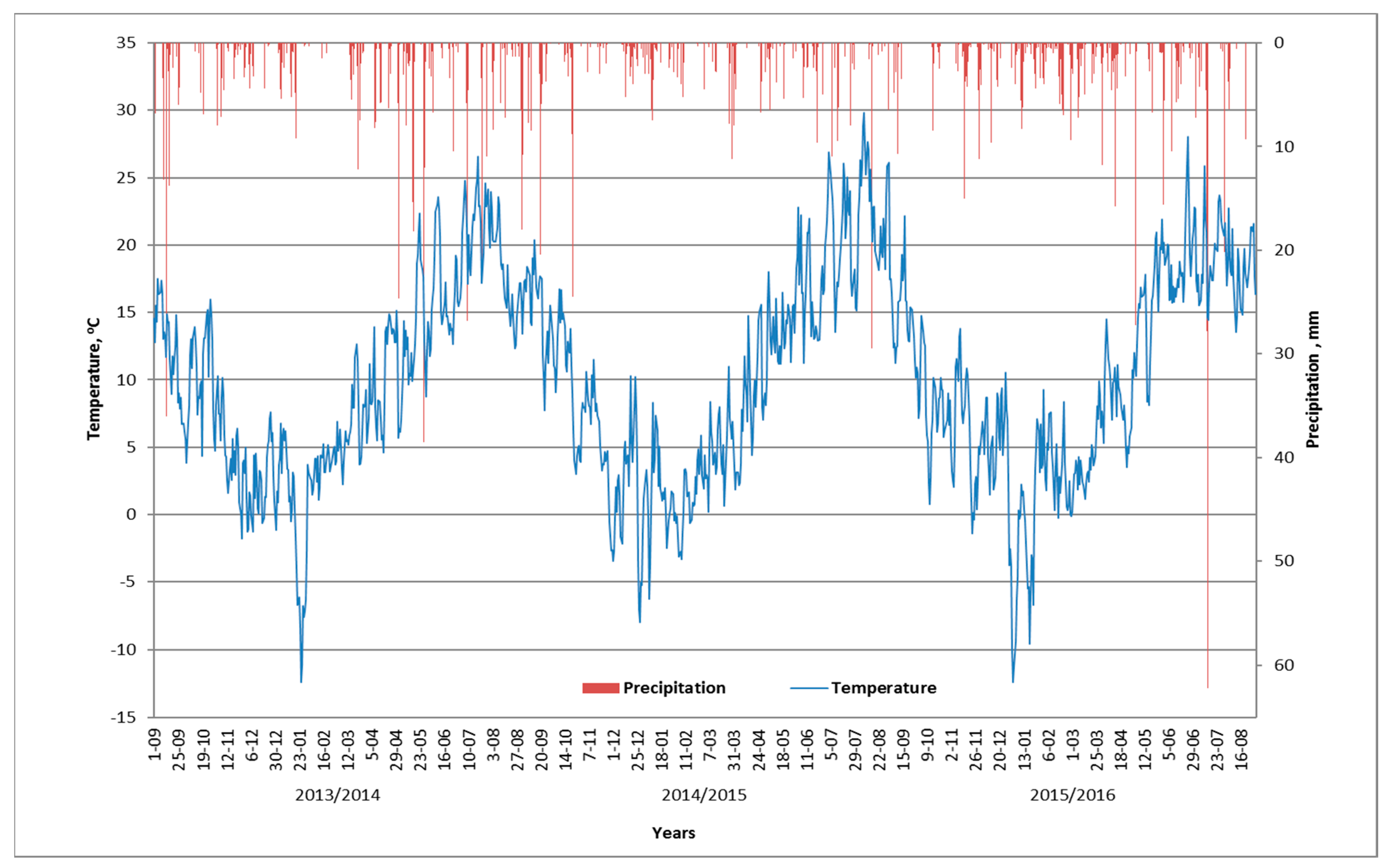
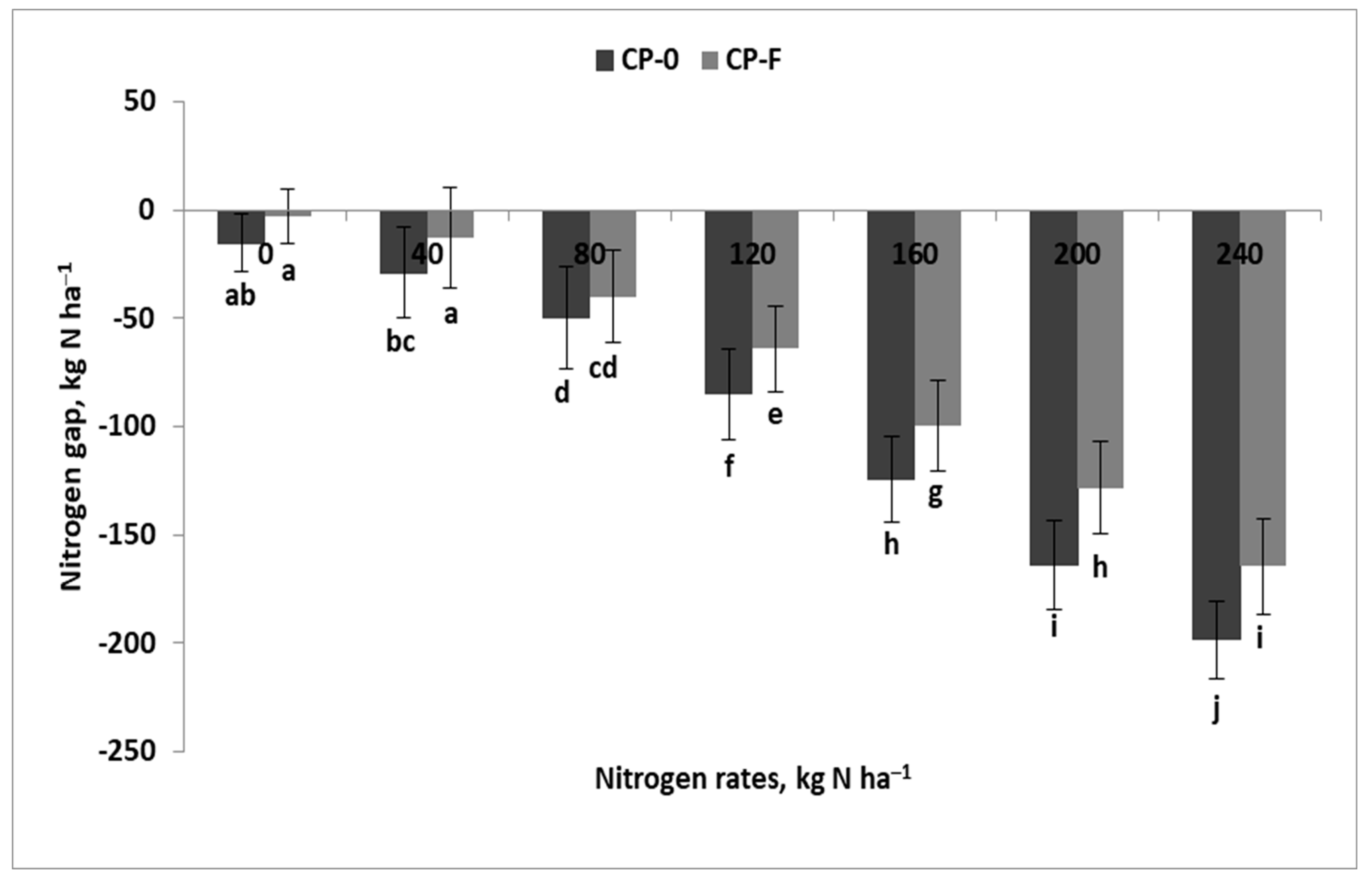
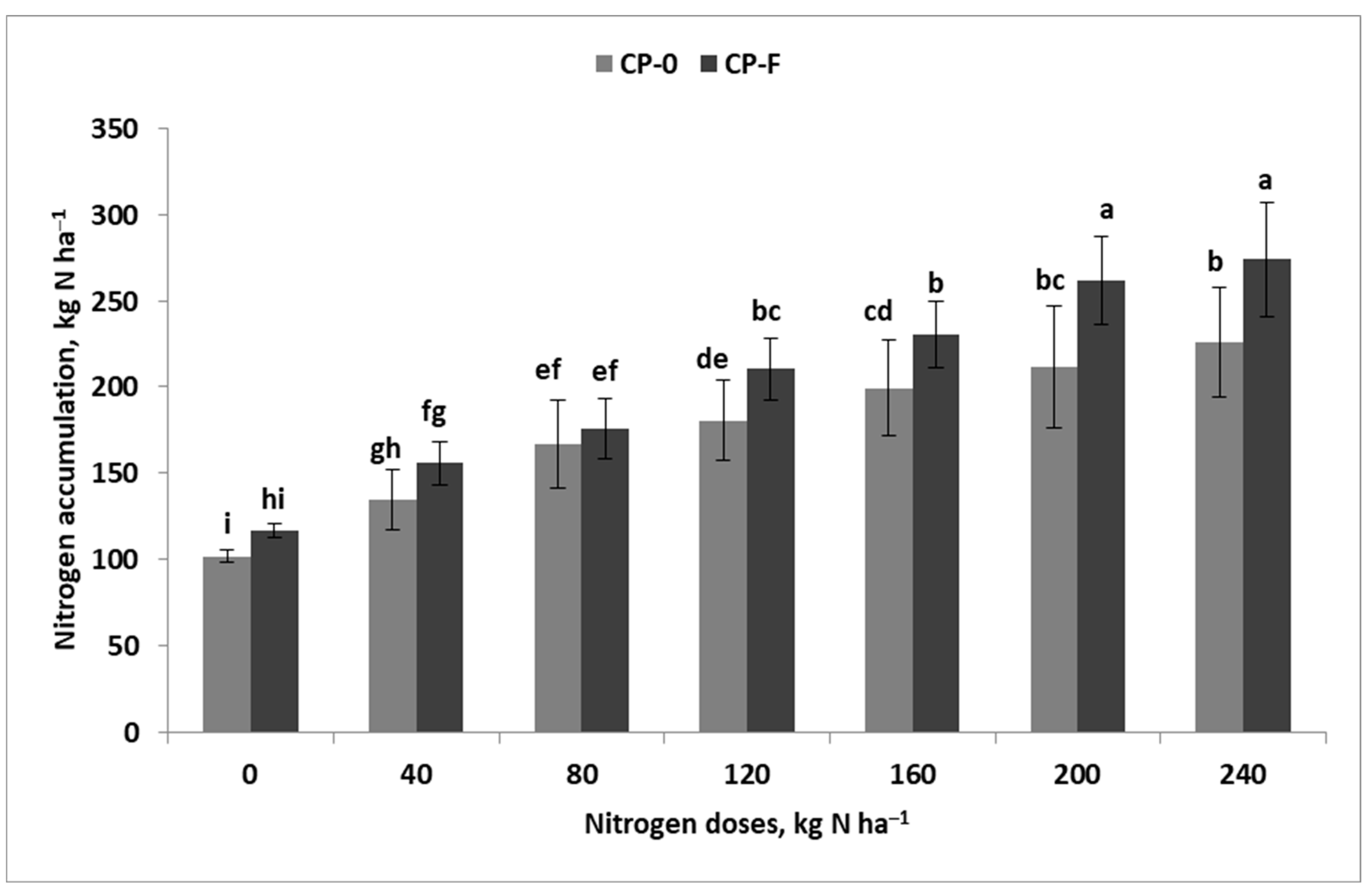
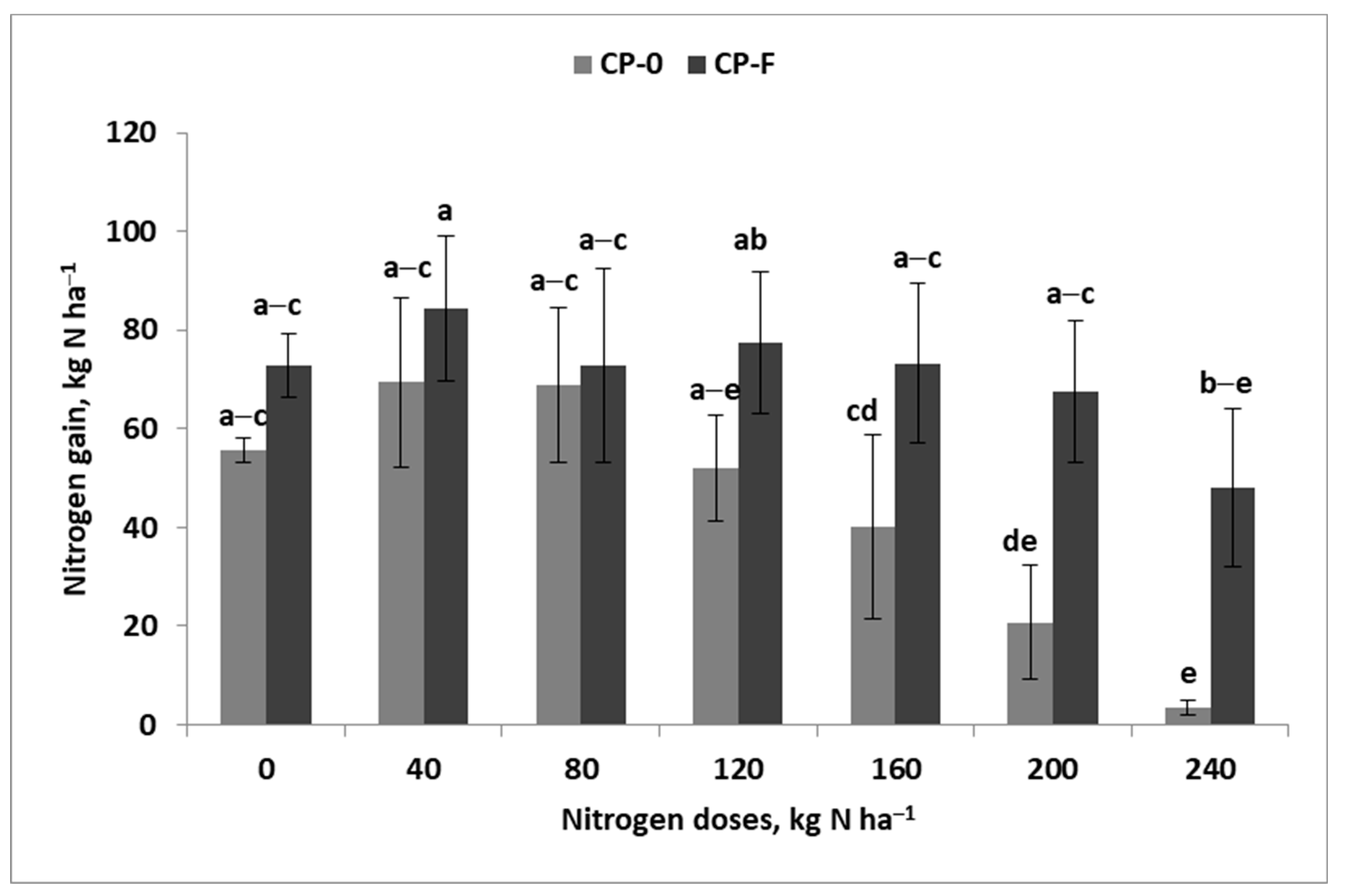

| Soil, cm | pH 1 | Corg 2 | P 3 | K | Mg | Ca | Cu | Mn | Zn | Fe | Nmin 4 |
|---|---|---|---|---|---|---|---|---|---|---|---|
| % | mg kg−1 | kg ha−1 | |||||||||
| 2013/2014 | |||||||||||
| 0–30 | 6.9 | 1.3 | 234 VH 5 | 231 M | 105 VL | 988 L | 0.4 L | 27.2 L | 3.6 M | 536 H | 86.4 |
| 30–60 | 6.7 | 1.1 | 234 VH | 237 M | 103 VL | 876 L | 0.4 L | 25.7 L | 3.5 M | 541 H | |
| 2014/2015 | |||||||||||
| 0–30 | 7.1 | 2.2 | 185 H | 185 M | 165 M | 2045 M | 3.5 M | 85.5 M | 6.3 H | 268 M | 129 |
| 30–60 | 7.2 | 2.1 | 161 H | 157 L | 155 L | 2063 M | 3.5 M | 93.8 M | 5.6 H | 26 9 M | |
| 2015/2016 | |||||||||||
| 0–30 | 6.6 | 1.6 | 202 VH | 281 M | 165 M | 1480 L | 2.8 M | 61.9 M | 6.1 H | 347 M | 110 |
| 30–60 | 6.6 | 1.4 | 139 H | 222 M | 163 L | 1504 L | 2.5 M | 62.0 M | 3.7 M | 231 M | |
| Variable | Level of Variable | Nin | GY | PFP-Nin | YG | NG |
|---|---|---|---|---|---|---|
| kg ha−1 | t ha−1 | kg kg−1 N | t ha−1 | kg ha−1 | ||
| Year (Y) | 2014 | 206.3 c | 8.8 b | 48.2 a | −3.7 a | −61.7 a |
| 2015 | 249.0 a | 11.0 a | 46.5 b | −4.8 b | −68.8 b | |
| 2016 | 230.0 b | 6.6 c | 31.1 c | −7.4 c | −121.7 c | |
| Fc, p | ne | 736 *** | 441 *** | 611 *** | 611 *** | |
| Crop Protection | CP-0 | 228.4 | 8.1 b | 38.9 b | −5.8 b | −95.0 b |
| (CP) | CP-F | 228.4 | 9.4 a | 45.0 a | −4.4 a | −73.1 a |
| Fc, p | ne | 205 *** | 137 *** | 205 *** | 205 *** | |
| 0 | 108.5 | 6.0 e | 57.0 a | −0.6 a | −9.1 a | |
| Nitrogen rates | 40 | 148.5 | 7.8 d | 52.7 b | −1.3 b | −20.9 b |
| (N), kg N ha−1 | 80 | 188.5 | 8.7 c | 46.4 c | −2.7 c | −44.8 c |
| 120 | 228.5 | 9.4 b | 41.0 d | −4.5 d | −74.5 d | |
| 160 | 268.4 | 9.5 b | 35.4 e | −6.8 e | −111.9 e | |
| 200 | 308.4 | 9.9 a b | 31.9 f | −8.9 f | −146.0 f | |
| 240 | 348.5 | 10.2 a | 29.1 f | −11.0 g | −181.4 g | |
| Fc, p | ne | 137 *** | 237 *** | 1030 *** | 1030 *** | |
| Source of variation for the studied interactions | ||||||
| Y × CP | - | *** | *** | *** | *** | |
| Y × N | - | *** | *** | *** | *** | |
| CP × N | - | *** | ns | *** | *** | |
| Y × CP × N | - | ns | ns | ns | ns | |
| Variable | Level of Variable | Ngr | Nhrr | NA | Nminr | Nb | Ng89 | Nint | PFP-Nint | NGt | NR |
|---|---|---|---|---|---|---|---|---|---|---|---|
| kg N ha−1 | kg kg−1 N | kg N ha−1 | % | ||||||||
| Year (Y) | 2014 | 174.9 b | 45.8 b | 220.7 c | 25.7 c | −14.4 b | 40.0 b | 246.3 c | 36.6 a | −22.2 a | 87.5 b |
| 2015 | 229.9 a | 66.0 a | 295.9 a | 48.4 a | −46.9 c | 95.5 a | 344.4 a | 32.4 b | −64.8 b | 132.2 a | |
| 2016 | 162.3 c | 68.0 a | 230.2 b | 37.3 b | −0.2 a | 37.5 b | 267.5 b | 25.3 c | −99.3 c | 69.3 c | |
| Fc, p | 264 *** | 45.5 *** | 214 *** | 48.9 *** | 73.2 *** | 91.4 *** | 228 *** | 306 *** | 179 *** | 61 *** | |
| Crop Protection | CP-0 | 184.4 b | 62.6 a | 237.0 b | 35.8 | −8.6 a | 44.3 b | 272.8 b | 30.5 b | −65.8 b | 94.3 |
| (CP) | CP-F | 203.6 a | 57.2 b | 260.9 a | 38.5 | −32.4 b | 70.9 a | 299.4 a | 32.4 a | −58.5 a | 98.4 |
| Fc, p | 131 *** | 6.7 * | 54.4 *** | 2.1 ns | 54.5 *** | 45.3 *** | 45.3 *** | 25.4 *** | 4.8 * | 0.7 ns | |
| 0 | 109.3 f | 34.8 e | 144.1 g | 28.7 d | −35.6 d | 64.3 ab | 172.7 f | 35.4 a | −18.6 a | - | |
| Nitrogen rates | 40 | 145.3 e | 49.3 d | 194.5 f | 30.8 cd | −46.1 d | 76.8 a | 225.3 e | 34.4 a | −27.5 a | 134.1 a |
| (N), kg N ha−1 | 80 | 171.6 d | 55.1 cd | 226.7 e | 32.7 cd | −38,2 d | 70.9 a | 259.3 d | 33.8 ab | −36.5 ab | 103.2 b |
| 120 | 195.6 c | 61.7 bc | 257.3 d | 36.0 b–d | −28.8 cd | 64.8 ab | 293.3 c | 32.0 b | −54.5 b | 94.3 bc | |
| 160 | 214.9 b | 71.1 ab | 286.0 c | 39.1 a–c | −17,6 c | 56.7 ab | 325.1 b | 29.4 c | −82.4 cd | 88.7 c | |
| 200 | 236.6 a | 70.9 ab | 307.5 b | 45.0 ab | 0.9 b | 44.1 bc | 352.5 a | 27.9 cd | −100.5 cd | 81.7 cd | |
| 240 | 249.9 a | 76.6 a | 326.6 a | 47.7 a | 21.0 a | 25.8 c | 374.2 a | 27.2 d | −114.9 d | 76.0 d | |
| Fc, p | 222 *** | 28.0 *** | 231 *** | 8.3 *** | 32.2 *** | 11.2 *** | 189 *** | 44.4 *** | 72.6 *** | 12.6 *** | |
| Source of variation for the studied interactions | |||||||||||
| Y × CP | ** | ns | * | * | * | * | * | ** | ns | *** | |
| Y × N | *** | ns | *** | *** | *** | *** | *** | ** | ns | * | |
| CP × N | *** | ns | ns | ns | ns | * | * | ns | ns | ns | |
| Y × CP × N | ns | ns | ns | ns | ns | ns | ns | ns | ns | ns | |
Disclaimer/Publisher’s Note: The statements, opinions and data contained in all publications are solely those of the individual author(s) and contributor(s) and not of MDPI and/or the editor(s). MDPI and/or the editor(s) disclaim responsibility for any injury to people or property resulting from any ideas, methods, instructions or products referred to in the content. |
© 2024 by the authors. Licensee MDPI, Basel, Switzerland. This article is an open access article distributed under the terms and conditions of the Creative Commons Attribution (CC BY) license (https://creativecommons.org/licenses/by/4.0/).
Share and Cite
Andrzejewska, A.; Szczepaniak, W.; Szymański, T. Fungicide Protection as an Agrotechnical Treatment Reducing Nitrogen Gap in Winter Wheat—A Case Study. Agronomy 2024, 14, 1785. https://doi.org/10.3390/agronomy14081785
Andrzejewska A, Szczepaniak W, Szymański T. Fungicide Protection as an Agrotechnical Treatment Reducing Nitrogen Gap in Winter Wheat—A Case Study. Agronomy. 2024; 14(8):1785. https://doi.org/10.3390/agronomy14081785
Chicago/Turabian StyleAndrzejewska, Agnieszka, Witold Szczepaniak, and Tomasz Szymański. 2024. "Fungicide Protection as an Agrotechnical Treatment Reducing Nitrogen Gap in Winter Wheat—A Case Study" Agronomy 14, no. 8: 1785. https://doi.org/10.3390/agronomy14081785
APA StyleAndrzejewska, A., Szczepaniak, W., & Szymański, T. (2024). Fungicide Protection as an Agrotechnical Treatment Reducing Nitrogen Gap in Winter Wheat—A Case Study. Agronomy, 14(8), 1785. https://doi.org/10.3390/agronomy14081785






